Whew! 2020 is behind us. And what a year it was, right? Normally, I am exhausted in January because of the excitement of the holidays. But now, I think I am just exhausted because of 2020 as a whole. And it doesn’t help that January is such a cold, dark and dreary month. So this month, let’s create a sensational craft that will help us relax and have some “me time”.
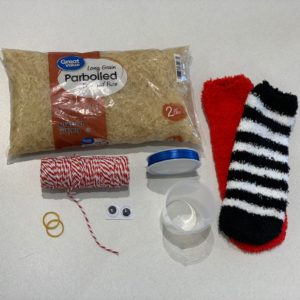
Supplies needed:
- Sock, preferably a brand new one
- Rice or dried beans
- Small scoop or measuring cup
- Rubber band or needle and thread
- Ribbon or string
- Dried flowers or herbs, such as lavender (optional)
- Wiggly eyes (optional)
- Glue (if you use wiggly eyes)
This project is super easy. When choosing your sock, make sure you pick one that has a texture that you like. Personally, I love the super soft, fuzzy socks you can find this time of year. If you don’t like that texture, find something that will be calming and relaxing for you. All you have to do is scoop the rice or beans into the sock. Fill it about 3/4 full. You can decide how much you feel is appropriate. If you use less rice, then the pillow will be more flexible and will mold better to your face. If you use more, it will be heavier, so you get even more deep-pressure sensory input, which can be more calming.
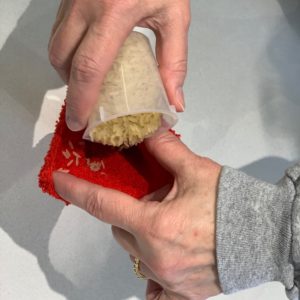
If desired, you can add some dried flowers or herbs to the sock with the rice. Lavender is typically known for its calming properties. But be aware sometimes lavender can have the opposite effect and can actually energize you, so use it with caution. Pick something you like that is calming for you. I also do not recommend using essential oils for this project since they will be used near the eyes.
Take the rubber band and wrap it around as many times as you can to keep the top of the sock closed. Alternatively, you can use a needle and thread to sew the sock closed.
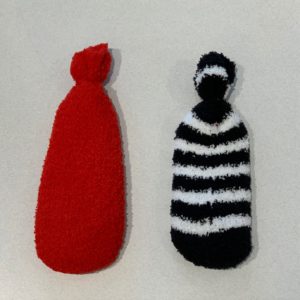
Then tie a pretty ribbon or string around it. For fun, go ahead and glue some wiggly eyes onto your sock to give it some personality.
DISCLAIMER: Do not use wiggly eyes if you will be using this with a small child who might put the eyes in their mouth.
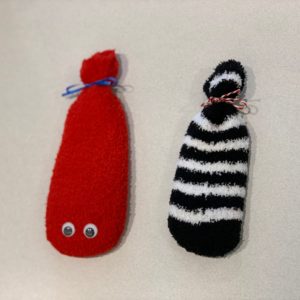
To use, simply heat the sock in the microwave for 30-60 seconds. If you put wiggly eyes on your sock, skip this step, as you don’t want to melt the plastic eyes. Your heating time may vary depending on your microwave.
Once you take it out of the microwave, massage it a little to mix up the rice and distribute the heat. Adults should test it before giving it to young children to ensure it is not too hot. Then find a comfortable position, place the pillow on your eyes, and relax. Feel free to play some of the music that I recommended in my blog post about making sensory bottles. This pillow can be used on your eyes, your head or anywhere you desire. When using with a child, adult supervision is recommended.
I would recommend only using this for about twenty minutes at a time. After twenty minutes, your body gets used to the weight, and the pillow will lose some of its calming effects.
Because this sock has rice in it, it won’t last forever. If you start to notice it smelling funky, all you have to do is empty the rice, wash the sock, and refill it with new rice. Along those same lines, if your eye pillow gets wet or dirty, the rice should be replaced, and the sock washed.
What senses are active when using the eye pillow?
- Touch: You can feel the heat on your skin if you microwave your pillow. You can also feel the texture of the sock.
- Smell: The rice may have a bit of a smell to it, especially if heated. If you use lavender or another dried flower or herb, you will definitely have more of an olfactory experience. Last month, I talked about the importance of the sense of smell.
- Proprioceptive (deep pressure): Feel the weight of the pillow on your body as you relax. Why does deep pressure work? It helps stimulate the release of dopamine and serotonin, two chemicals in your brain that help you feel more relaxed.
Do you need some more help in learning how to relax and be mindful? Check out these books!
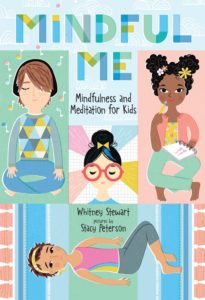
Mindful Me: Mindfulness and Meditation for Kids by Whitney Stewart
Sometimes kids’ lives can get busy and out of control, and worries can take over. When that happens, knowing how to pause and regain composure with mindfulness can help! This easily digestible guide introduces kids to mindfulness as a way to find clarity, manage stress, handle difficult emotions and navigate personal challenges. With step-by-step instructions for over 30 breathing, relaxation and guided meditation exercises, readers will have an entire toolkit at their disposal, and writing prompts will help them process their discoveries.
Find It Now

Meditation for Kids: How to Clear Your Head and Calm Your Mind by Johanne J. Bernard
This extensive guide introduces the benefits of meditation for children and explores ways to stay calm, focused and confident in order to work through daily stresses and manage tough emotions. It features options for both seated and walking meditation practices with over a dozen illustrated, step-by-step exercises like the tightrope walker and the flamingo.
Find It Now
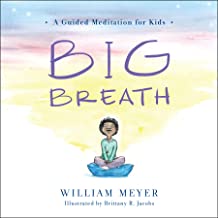
Big Breath: A Guided Meditation for Kids by William J. Meyer
In Big Breath, William Meyer’s gentle prompts, alongside Brittany R. Jacobs’s wonderful illustrations, make meditation as fun as a game but with big results.
Find It Now
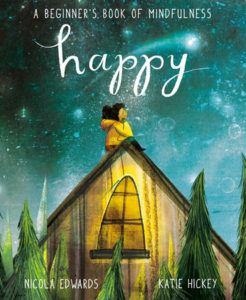
Happy by Nicola Edwards and Katie Hickey
We breathe deep and expand like the galaxy. We breathe out many thousands of stars. And if ever we start to feel panicky, this reminds us of just who we are. The perfect soothing read for quiet time, Happy gently encourages young readers to explore their emotions and the beautiful world around them with stunning illustrations and thought-provoking rhymes on every page. This poetic journey to a place of happiness and calm will inspire and empower your child to enjoy the practice of mindfulness.
